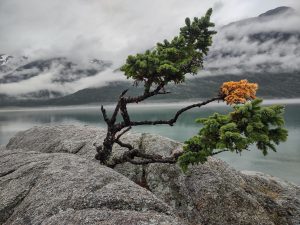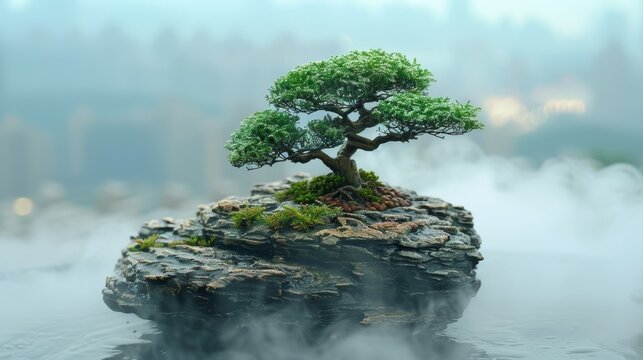Where do bonsai trees grow naturally?
Bonsai trees are known for their small stature and complex beauty, and they have attracted enthusiasts all around the world. To understand where do bonsai trees grow naturally, one must investigate their origins and the ecosystems that support them.
Origins of Bonsai Trees
Bonsai, a Japanese phrase that means “planted in a container,” is a style of art that originated in ancient China. Originally called “penjing,” this practice entailed making miniature landscapes. Japanese Zen Buddhism later adopted and developed this method, focusing on single trees, giving rise to what we now call bonsai. These little trees are not different species, but rather conventional trees that have grown to be small.
Where do bonsai trees grow naturally?
Natural habitats of bonsai species

Temperate Regions of East Asia
Many bonsai species survive in East Asia’s temperate zones. These places provide a good climate for many of the trees used in bonsai, including maples, pines, and junipers.
Japan
Japan is the centre of bonsai culture. Native plants thrive here, including the Japanese Maple (Acer palmatum), Japanese Black Pine (Pinus thunbergii), and Juniper (Juniperus spp.). These species are well-adapted to Japan’s unusual four-season environment, which features hot summers and cold winters that are ideal for the growth cycles of many bonsai plants.
China
China, the birthplace of the penjing tradition, is home to a diverse range of bonsai-friendly species. The Chinese Elm (Ulmus parvifolia) and Serissa (Serissa foetida) are two notable examples. These trees flourish in China’s different climates, which range from temperate to subtropical.
The subtropical and tropical regions
Some bonsai species originate in subtropical and tropical locations, where the habitat promotes growth.
India and Southeast Asia
Banyan Figs (Ficus benghalensis) and Jade Trees (Crassula ovata) are common in warmer climes in India and Southeast Asia. These trees thrive in these humid, warm environments. Their intrinsic resistance to high temperatures and fluctuating rainfall patterns make them suitable for bonsai cultivation in similar regions.
The Mediterranean Basin
The Mediterranean Basin, with its hot, dry summers and mild, wet winters, is another area where bonsai species thrive. Notable examples are the olive tree (Olea europaea) and the pomegranate (Punica granatum). These species have evolved to thrive in less water, making them ideal for bonsai forms that capture their natural, rough beauty.
Adapting Bonsai for Different Climates

Understanding climate requirements
Despite their native origins, bonsai trees can thrive in global climates with the right care. Understanding the climatic needs of each species is critical. Temperate species, such as maples and pines, require a period of dormancy during cooler winter temperatures, whereas tropical species, such as figs and jades, require constantly warm circumstances.
Creating suitable microclimates
Creating an appropriate microclimate for bonsai entails simulating the tree’s natural environment. Carefully managing temperature, humidity, and light exposure can accomplish this. For example, temperate plants may require a cold frame or greenhouse to imitate winter conditions, while tropical species benefit from indoor cultivation during the cooler months.
Techniques for cultivating bonsai
Pruning and Shaping
Pruning and shaping are key methods in bonsai cultivation. This entails deliberately cutting branches and roots to regulate the tree’s growth while maintaining its small size. Wiring is another technique for guiding branch growth and achieving the desired aesthetic appearance.
Soil and water requirements
Bonsai trees require soil combinations that drain well while holding moisture. A popular mixture consists of akadama (a form of volcanic clay), pumice, and organic stuff. Proper watering is essential since bonsai are sensitive to both overwatering and underwatering. The frequency and amount of watering vary depending on the species and environment.
Fertiliser and Pest Control
Regular fertilisation ensures that bonsai trees get enough nutrients to develop. We generally recommend organic fertilisers because of their gradual release features. Bonsai trees, like all plants, are prone to pests and illnesses. Regular inspections and proper pest management procedures are required to keep them healthy.
Related Posts:
FAQS
What are bonsai trees?
Ordinary trees, known as bonsai trees, undergo pruning and shaping to maintain their small size. People commonly maintain them in containers to replicate full-sized trees in miniature form.
Can bonsai trees flourish outside of their natural habitats?
Yes, with proper care, bonsai trees may thrive in a variety of climates around the world. Controlling temperature, humidity, and light is critical for creating an appropriate microclimate.
What are the most prevalent bonsai species?
The most common bonsai species are:
Japanese maple (Acer palmatum).
Chinese Elm (Ulmus parvifolia).
Junipers (Juniperus spp.
Banyan Figs (Ficus benghalensis)
Jade Tree (Crassula Ovata)
What are the main care requirements for bonsai trees?
Pruning and shaping: Trim branches and roots regularly to keep them in shape and size.
Soil and Watering: Use well-drained soil combinations and suitable watering methods.
Fertilisation: Apply organic fertilizers regularly.
Pest Control: Regular inspections and effective pest treatment.
Conclusion
Bonsai trees, though cultivated to be miniature, come from a range of natural settings all over the world. Japan and China have moderate climates, as do Southeast Asia and the Mediterranean Basin. Bonsai enthusiasts can develop and preserve these gorgeous trees by understanding and recreating their natural surroundings. Bonsai necessitates not only knowledge of certain species and their natural conditions, but dedication, meticulous care, and patience to ensure that these little marvels thrive in any environment.




